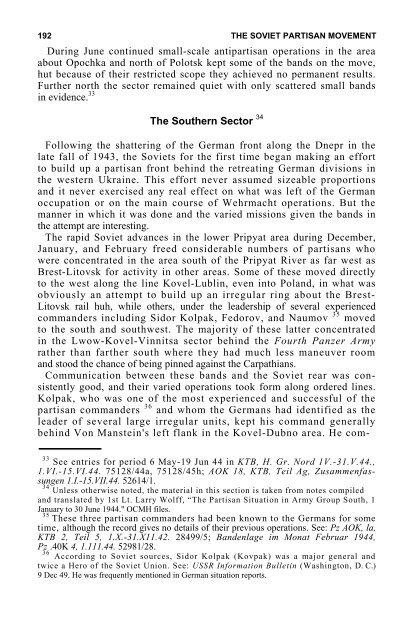the soviet partisan movement 1941-1944 by edgar m. howell
the soviet partisan movement 1941-1944 by edgar m. howell
the soviet partisan movement 1941-1944 by edgar m. howell
Create successful ePaper yourself
Turn your PDF publications into a flip-book with our unique Google optimized e-Paper software.
192 THE SOVIET PARTISAN MOVEMENT<br />
During June continued small-scale anti<strong>partisan</strong> operations in <strong>the</strong> area<br />
about Opochka and north of Polotsk kept some of <strong>the</strong> bands on <strong>the</strong> move,<br />
hut because of <strong>the</strong>ir restricted scope <strong>the</strong>y achieved no permanent results.<br />
Fur<strong>the</strong>r north <strong>the</strong> sector remained quiet with only scattered small bands<br />
in evidence. 33 The Sou<strong>the</strong>rn Sector 34<br />
Following <strong>the</strong> shattering of <strong>the</strong> German front along <strong>the</strong> Dnepr in <strong>the</strong><br />
late fall of 1943, <strong>the</strong> Soviets for <strong>the</strong> first time began making an effort<br />
to build up a <strong>partisan</strong> front behind <strong>the</strong> retreating German divisions in<br />
<strong>the</strong> western Ukraine. This effort never assumed sizeable proportions<br />
and it never exercised any real effect on what was left of <strong>the</strong> German<br />
occupation or on <strong>the</strong> main course of Wehrmacht operations. But <strong>the</strong><br />
manner in which it was done and <strong>the</strong> varied missions given <strong>the</strong> bands in<br />
<strong>the</strong> attempt are interesting.<br />
The rapid Soviet advances in <strong>the</strong> lower Pripyat area during December,<br />
January, and February freed considerable numbers of <strong>partisan</strong>s who<br />
were concentrated in <strong>the</strong> area south of <strong>the</strong> Pripyat River as far west as<br />
Brest-Litovsk for activity in o<strong>the</strong>r areas. Some of <strong>the</strong>se moved directly<br />
to <strong>the</strong> west along <strong>the</strong> line Kovel-Lublin, even into Poland, in what was<br />
obviously an attempt to build up an irregular ring about <strong>the</strong> Brest-<br />
Litovsk rail huh, while o<strong>the</strong>rs, under <strong>the</strong> leadership of several experienced<br />
commanders including Sidor Kolpak, Fedorov, and Naumov 35 moved<br />
to <strong>the</strong> south and southwest. The majority of <strong>the</strong>se latter concentrated<br />
in <strong>the</strong> Lwow-Kovel-Vinnitsa sector behind <strong>the</strong> Fourth Panzer Army<br />
ra<strong>the</strong>r than far<strong>the</strong>r south where <strong>the</strong>y had much less maneuver room<br />
and stood <strong>the</strong> chance of being pinned against <strong>the</strong> Carpathians.<br />
Communication between <strong>the</strong>se bands and <strong>the</strong> Soviet rear was consistently<br />
good, and <strong>the</strong>ir varied operations took form along ordered lines.<br />
Kolpak, who was one of <strong>the</strong> most experienced and successful of <strong>the</strong><br />
<strong>partisan</strong> commanders 36 and whom <strong>the</strong> Germans had identified as <strong>the</strong><br />
leader of several large irregular units, kept his command generally<br />
behind Von Manstein's left flank in <strong>the</strong> Kovel-Dubno area. He com<br />
33 See entries for period 6 May-19 Jun 44 in KTB, H. Gr. Nord 1V.-31.V.44.,<br />
1.VI.-15.VI.44. 75128/44a, 75128/45h; AOK 18, KTB, Teil Ag, Zusammenfassungen<br />
1.I.-15.VII.44. 52614/1.<br />
34 Unless o<strong>the</strong>rwise noted, <strong>the</strong> material in this section is taken from notes compiled<br />
and translated <strong>by</strong> 1st Lt. Larry Wolff, “The Partisan Situation in Army Group South, 1<br />
January to 30 June <strong>1944</strong>." OCMH files.<br />
35<br />
These three <strong>partisan</strong> commanders had been known to <strong>the</strong> Germans for some<br />
time, although <strong>the</strong> record gives no details of <strong>the</strong>ir previous operations. See: Pz AOK, la,<br />
KTB 2, Teil 5, 1.X.-31.X11.42. 28499/5; Bandenlage im Monat Februar <strong>1944</strong>,<br />
Pz .40K 4, 1.111.44. 52981/28.<br />
36 According to Soviet sources, Sidor Kolpak (Kovpak) was a major general and<br />
twice a Hero of <strong>the</strong> Soviet Union. See: USSR Information Bulletin (Washington, D. C.)<br />
9 Dec 49. He was frequently mentioned in German situation reports.
















